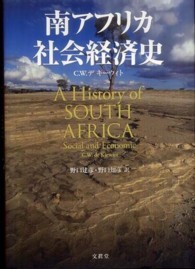- ホーム
- > 洋書
- > 英文書
- > Science / Mathematics
Full Description
This comprehensive volume discusses the patterns and processes analyzed in macroecology with a distinct look at the theoretical and methodological issues underlying the discipline as well as deeper epistemological matters. The book serves as a synthesis of macroecological literature that has been published since Brown and Maurer proposed and defined the term "macroecology" in 1989. Author José Alexandre Felizola Diniz-Filho draws from the different disciplines and branches (ecology, evolutionary biology, physiology, behavioral sciences, climatology, and paleontology) that make up macroecology to present a full, holistic picture of where the discipline stands.
Through ten chapters, Diniz-Filho moves from a discussion of what macroecology actually is to macroecological modeling to the more applied side of the discipline, covering topics such as richness and diversity patterns and patterns in body size. The book concludes with a synthesis of how macroecological researchis done in a theoretical and operational sense as well as unifying explanations for each of the macroecological patterns discussed, moving on to evaluate which theories and models are still useful and which ones can be abandoned. The book is intended for academics, young researchers and students interested in macroecology and conservation biogeography. In addition, because of the integrative nature of macroecology and the theoretical and methodological background in the book, it can be of interest to researchers working in related fields including but not limited to ecology and evolutionary biology.
Contents
Chapter 1. Introduction.- Chapter Two. Theories and Models.- Chapter 3. The Structure of Macroecological Data.- Chapter 4. Structure and Dynamics of Geographic Ranges.- Chapter 5. The Macroecological Understanding of Ecological Niches.- Chapter 6. Richness and Diversity Patterns.- Chapter 7. Macroecological Assemblages.- Chapter 8. Patterns in Body Size.- Chapter 9. From Theoretical to Applied Macroecology.- Chapter 10. Concluding Remarks.








